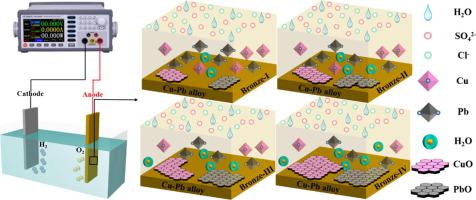Journal of Electroanalytical Chemistry ( IF 4.1 ) Pub Date : 2021-09-09 , DOI: 10.1016/j.jelechem.2021.115688 Zhipeng Liang 1 , Kaixi Jiang 1, 2 , Bai-ao Feng 1 , Shengnan Lin 1 , Xi Chao 1 , Qinqin Sui 1 , Ting-an Zhang 1

|
The corrosion behaviour study of Cu-Pb alloy in simulated archaeological soil environment were investigated using electrochemical accelerated corrosion, Field emission scanning electron microscopy/energy dispersive spectroscopy, laser scanning confocal microscope, X-ray photoelectron spectroscopy and electrochemical methods. It is crucial that the corrosion resistance of the Cu-Pb alloy was found to alter with the Pb content in the alloy. The results demonstrated that Cu-13.28Pb alloy exhibited the best corrosion resistance with the smallest corrosion current density and the lowest anodic dissolution rate. The corrosion products are mainly composed of matrix metal oxides and metal-insoluble inert compounds. The correlation between Pb content and corrosion behaviour and the corresponding corrosion mechanism were clarified.
中文翻译:

模拟考古土壤环境中西周铜铅合金的腐蚀演化
采用电化学加速腐蚀、场发射扫描电子显微镜/能量色散光谱、激光扫描共聚焦显微镜、X射线光电子能谱和电化学方法研究了铜铅合金在模拟考古土壤环境中的腐蚀行为。发现 Cu-Pb 合金的耐腐蚀性随合金中 Pb 含量而变化是至关重要的。结果表明,Cu-13.28Pb合金的耐腐蚀性能最好,腐蚀电流密度最小,阳极溶解速率最低。腐蚀产物主要由基体金属氧化物和金属不溶性惰性化合物组成。阐明了铅含量与腐蚀行为之间的相关性以及相应的腐蚀机制。











































 京公网安备 11010802027423号
京公网安备 11010802027423号